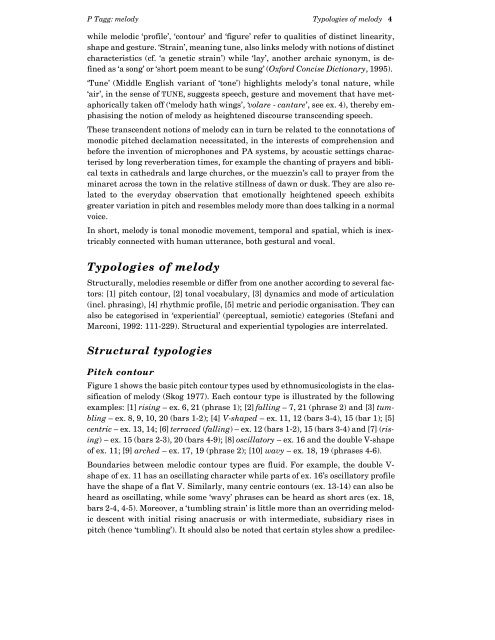Melody and Accompaniment - Philip Tagg
Melody and Accompaniment - Philip Tagg
Melody and Accompaniment - Philip Tagg
You also want an ePaper? Increase the reach of your titles
YUMPU automatically turns print PDFs into web optimized ePapers that Google loves.
P <strong>Tagg</strong>: melody Typologies of melody 4<br />
while melodic ‘profile’, ‘contour’ <strong>and</strong> ‘figure’ refer to qualities of distinct linearity,<br />
shape <strong>and</strong> gesture. ‘Strain’, meaning tune, also links melody with notions of distinct<br />
characteristics (cf. ‘a genetic strain’) while ‘lay’, another archaic synonym, is defined<br />
as ‘a song’ or ‘short poem meant to be sung’ (Oxford Concise Dictionary, 1995).<br />
‘Tune’ (Middle English variant of ‘tone’) highlights melody’s tonal nature, while<br />
‘air’, in the sense of TUNE, suggests speech, gesture <strong>and</strong> movement that have metaphorically<br />
taken off (‘melody hath wings’, ‘volare - cantare’, see ex. 4), thereby emphasising<br />
the notion of melody as heightened discourse transcending speech.<br />
These transcendent notions of melody can in turn be related to the connotations of<br />
monodic pitched declamation necessitated, in the interests of comprehension <strong>and</strong><br />
before the invention of microphones <strong>and</strong> PA systems, by acoustic settings characterised<br />
by long reverberation times, for example the chanting of prayers <strong>and</strong> biblical<br />
texts in cathedrals <strong>and</strong> large churches, or the muezzin’s call to prayer from the<br />
minaret across the town in the relative stillness of dawn or dusk. They are also related<br />
to the everyday observation that emotionally heightened speech exhibits<br />
greater variation in pitch <strong>and</strong> resembles melody more than does talking in a normal<br />
voice.<br />
In short, melody is tonal monodic movement, temporal <strong>and</strong> spatial, which is inextricably<br />
connected with human utterance, both gestural <strong>and</strong> vocal.<br />
Typologies of melody<br />
Structurally, melodies resemble or differ from one another according to several factors:<br />
[1] pitch contour, [2] tonal vocabulary, [3] dynamics <strong>and</strong> mode of articulation<br />
(incl. phrasing), [4] rhythmic profile, [5] metric <strong>and</strong> periodic organisation. They can<br />
also be categorised in ‘experiential’ (perceptual, semiotic) categories (Stefani <strong>and</strong><br />
Marconi, 1992: 111-229). Structural <strong>and</strong> experiential typologies are interrelated.<br />
Structural typologies<br />
Pitch contour<br />
Figure 1 shows the basic pitch contour types used by ethnomusicologists in the classification<br />
of melody (Skog 1977). Each contour type is illustrated by the following<br />
examples: [1] rising – ex. 6, 21 (phrase 1); [2] falling – 7, 21 (phrase 2) <strong>and</strong> [3] tumbling<br />
– ex. 8, 9, 10, 20 (bars 1-2); [4] V-shaped – ex. 11, 12 (bars 3-4), 15 (bar 1); [5]<br />
centric – ex. 13, 14; [6] terraced (falling) – ex. 12 (bars 1-2), 15 (bars 3-4) <strong>and</strong> [7] (rising)<br />
– ex. 15 (bars 2-3), 20 (bars 4-9); [8] oscillatory – ex. 16 <strong>and</strong> the double V-shape<br />
of ex. 11; [9] arched – ex. 17, 19 (phrase 2); [10] wavy – ex. 18, 19 (phrases 4-6).<br />
Boundaries between melodic contour types are fluid. For example, the double Vshape<br />
of ex. 11 has an oscillating character while parts of ex. 16’s oscillatory profile<br />
have the shape of a flat V. Similarly, many centric contours (ex. 13-14) can also be<br />
heard as oscillating, while some ‘wavy’ phrases can be heard as short arcs (ex. 18,<br />
bars 2-4, 4-5). Moreover, a ‘tumbling strain’ is little more than an overriding melodic<br />
descent with initial rising anacrusis or with intermediate, subsidiary rises in<br />
pitch (hence ‘tumbling’). It should also be noted that certain styles show a predilec-














